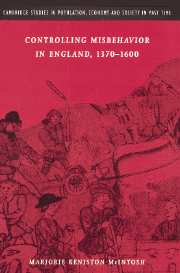Book contents
- Frontmatter
- Contents
- 1 List of illustrations
- 2 List of tables and lists
- Acknowledgements
- List of abbreviations
- Introduction
- Part I The history of social regulation
- Part II Factors that influenced social regulation
- Conclusion: social regulation and the transition from medieval to early modern England
- Appendices
- Bibliography
- Index
- Cambridge Studies in Population, Economy and Society in Past Time
Conclusion: social regulation and the transition from medieval to early modern England
Published online by Cambridge University Press: 23 November 2009
- Frontmatter
- Contents
- 1 List of illustrations
- 2 List of tables and lists
- Acknowledgements
- List of abbreviations
- Introduction
- Part I The history of social regulation
- Part II Factors that influenced social regulation
- Conclusion: social regulation and the transition from medieval to early modern England
- Appendices
- Bibliography
- Index
- Cambridge Studies in Population, Economy and Society in Past Time
Summary
To resolve the historiographic debates summarized in the Introduction, this study has explored four central questions concerning social regulation in England between 1370 and 1600. It began by describing the mechanisms through which misconduct could be addressed, looking at the role of informal and formal institutions and situating the courts within a wider setting for the resolution of conflicts. This analysis traced changes over time in the distribution of responsibility between local courts and those operating at an intermediate level (the church courts and county Sessions of the Peace), identified the essential part played by the thousands of public courts held within England's villages, market centers, and hundreds, and highlighted the personal agency of the jurors who dominated those institutions. Marked contrasts between the levels of activity of sixteenth-century local courts in accordance with their geographic location were also revealed. Secondly, the project has established in a quantified fashion the history of social regulation as handled by the lesser public courts. By analyzing eleven types of misconduct, it documented a general increase in concern with wrongdoing across the fifteenth and sixteenth centuries while revealing significant chronological variations in the specific sorts of offences that caused anxiety, in the gender of those reported, and in the procedures and punishments employed. A third question focused upon the attitudes that shaped local responses to misbehavior. Here we saw a set of core values held widely throughout society: preserving harmonious and tranquil relationships within a commuity; enforcing good order, control, and discipline; and developing some kind of appropriate response to the various kinds of poor people.
- Type
- Chapter
- Information
- Controlling Misbehavior in England, 1370–1600 , pp. 209 - 214Publisher: Cambridge University PressPrint publication year: 1998
- 1
- Cited by

